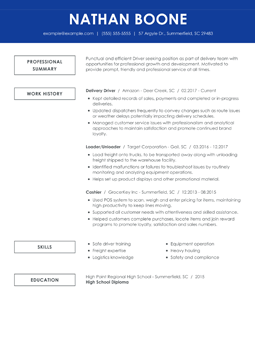This black-and-white resume template has a refined font that makes this resume serious yet contemporary, perfect for software engineers, UX designers or architects. The two-column layout allows you to pack a lot of information on one single page while keeping everything looking tidy.
How to Write a LaTeX Resume in 2024 With Examples
Create Your Resume Now
Table of Contents
Here are more resources that can help you
-
Resume/CV Templates
-
- Basic Resume Template
- Creative Resume Template
- Portfolio Resume Template
- Modern Resume Template
- ATS Resume Template
- One-Page Resume Template
- Google Docs Resume Template
- CV Template
- Biodata Resume Template
- Writer Resume Example
- High School Student Resume Example
- Internship Resume Example
- Entry Level Resume Example
- Massage Therapist Resume Example
- Medical Assistant Resume Example
- Cashier Resume Example
- BabySitter Resume Example
- Customer Service Example
- Attorney Resume Example
- Customer Service Representative Resume Example
- Teacher Resume Example
- Engineering Resume Example
- Nurse Resume Example
- Latex Resume Template
- College Student Resume Example
- High School Graduate Resume Example
-
Resume Help
If you’re looking for a free and completely customizable resume, LaTeX is an option to consider. With this guide, you’ll learn about the pros and cons of using LaTeX, how this software works for writing a resume and browse free LaTeX resume templates.
What is LaTeX?
LaTeX (pronounced lay – tech) is a software system anyone can use to create unique documents of all sorts: books, letters, academic papers and resumes. Stanford University professor Leslie Lamport created LaTeX in the 1980s to typeset complex mathematical equations into math textbooks. However, you can also use LaTeX to create unique resumes personalized for your specific needs.
LaTeX is entirely free software available to anyone with a computer, but it is a fairly complex system that requires you to learn how to code to build your resume. You’ll need to understand the formulas and commands particular to LaTeX to format and style your resume template to your liking. Although it has a steep learning curve, you can do it with some practice, and as a result, you’ll have a resume like no other.
Where can you download LaTeX?
If you decide to use LaTeX, you should prepare to spend at least an hour downloading and setting up the software — that is, if you have had some previous coding experience. If you don’t have any coding knowledge, the installation process will require more time until you get comfortable with the coding language.
You can download LaTeX from TeX distributions quickly and easily, according to what type of operating system you have on your computer (i.e., macOS, Linux, Windows and others).
Start your resume journey with our expertly curated list of templates—explore and get started now.
Who Should Use a LaTeX Resume and Why?
LaTeX resumes should be used by candidates who have plenty of years’ experience and education and want a resume that can fit as much information as possible. Because LaTeX allows you to customize every detail of your template and content, you can include additional resume sections that fit seamlessly into one page.
Candidates in engineering, mathematics, physics, programming and computer science commonly use LaTeX when publishing their academic work, so using it to build their resume will be second nature. We recommend you use LaTeX to make your resume if you’re already comfortable with this or other programming languages, or you genuinely want to learn to use this software. If you’re looking for an easily customizable and quick resume tool, there are better options, such as Hloom’s Resume Builder.
What are the pros and cons of using LaTeX?
Pros
- Entirely free software.
- Complete customization for your resume templates
- Allows you to build a matching cover letter.
- You don’t depend on word processors’ pesky formatting tools.
Cons
- Requires strong knowledge of coding.
- It’s a heavy software that requires at least one hour to install.
- You need to create a resume from scratch every time.
- Building a resume can be an hours-long process.
- Not ATS-friendly, especially with complex designs and unique formatting.
- Files can only be downloaded as a .tex or .dvi file, and file conversion is tricky.
Best LaTeX Resume and CV Examples
If you decide to go with LaTeX to build your resume, we curated a selection of LaTeX resume templates you can use for free. By clicking your preferred resume template, it will direct you to Overleaf, an online LaTeX editor where you can copy the template’s code and paste it into your LaTeX file. If you want to check out more resume templates that don’t use LaTeX, browse our template library for 100+ free and premium options.

This template has a black-and-white colorway and serif font that makes it ideal for law, medicine and more traditional fields. Its single-column layout and clean design make it easy to read.

The white space in this resume template beautifully balances out the bold lines that indicate each resume section. This smart-design feature will be attractive to graphic designers, fashion designers and video editors that want to show off their creative eye.

The purple section titles, highlighted phrases, graphs and fun icons make this an eye-catching resume. Videographers, marketing managers and teachers will value the importance of visual elements to communicate their professional achievements.

Soft shades of gray and steel blue add an air of sophistication to this streamlined template. Accountants, sales representatives and financial analysts will appreciate the sleekness and practicality of this template.

LaTeX Resume Takeaways
Although LaTeX is a viable tool for building a resume, there are a few takeaways from this article you should keep in mind when using this software.
LaTeX:
- Requires you to have a strong knowledge of coding and LaTeX’s particular coding commands.
- Is a reliable and free tool you can use to create a resume with no limitations as to what you can design and format.
- Looks more visually engaging than most free resume templates out there (but that also comes with its problems).
- Can be difficult to read by applicant tracking systems (ATS) because of its complex and non-traditional designs that make them visually striking.
- Can be hard to figure out even with knowledge of coding; reference online forums such as the LaTeX Community forum for help with any problems or questions.
Try Our Easily Customizable Resume Builder
If you want to easily customize your resume, have an aesthetically pleasing template, and cut and paste resume sections without affecting the formatting of your document, the Hloom Resume Builder should be your top choice.
In addition to its templates and practical design tools, our builder helps you write the content of your resume with text suggestions based on your desired job title. This all-around resume-writing tool also comes with a Cover Letter Builder, so you have a one-stop shop for all your job application needs.
More Articles Like This
Rate our Templates
Gabriela Barcenas
Gaby is Hloom’s resident writer, a certified professional resume writer (CPRW), and a baking enthusiast. She likes to defend the use of the functional resume to her friends in HR. She graduated from the University of San Francisco with a B.A. in English and Creative Writing and wrote about career growth, tech startups, education, fashion, travel and lifestyle culture throughout her career.

















